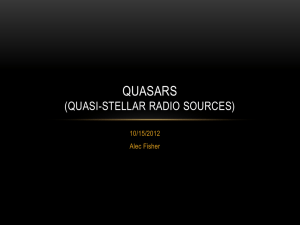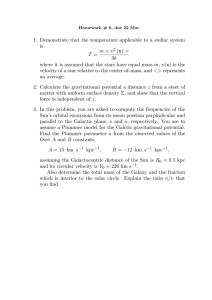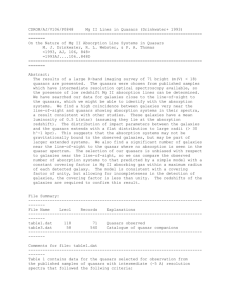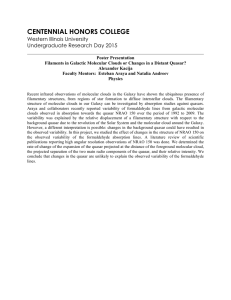A Substantial Mass of Cool, Metal-enriched Gas Please share
advertisement
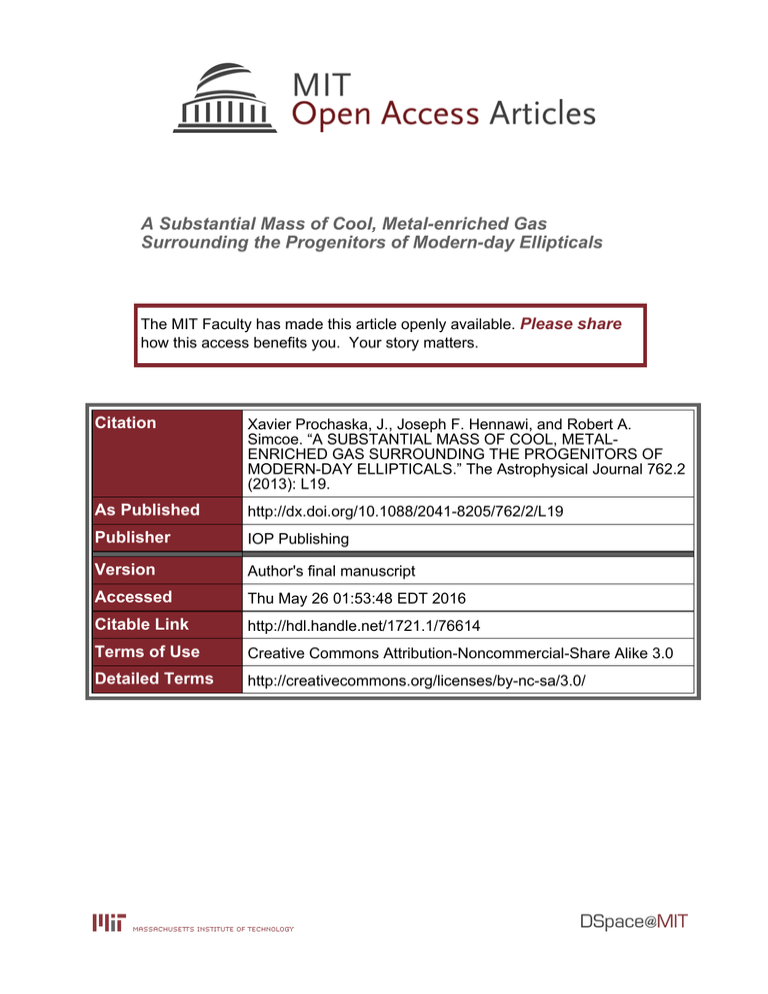
A Substantial Mass of Cool, Metal-enriched Gas Surrounding the Progenitors of Modern-day Ellipticals The MIT Faculty has made this article openly available. Please share how this access benefits you. Your story matters. Citation Xavier Prochaska, J., Joseph F. Hennawi, and Robert A. Simcoe. “A SUBSTANTIAL MASS OF COOL, METALENRICHED GAS SURROUNDING THE PROGENITORS OF MODERN-DAY ELLIPTICALS.” The Astrophysical Journal 762.2 (2013): L19. As Published http://dx.doi.org/10.1088/2041-8205/762/2/L19 Publisher IOP Publishing Version Author's final manuscript Accessed Thu May 26 01:53:48 EDT 2016 Citable Link http://hdl.handle.net/1721.1/76614 Terms of Use Creative Commons Attribution-Noncommercial-Share Alike 3.0 Detailed Terms http://creativecommons.org/licenses/by-nc-sa/3.0/ Draft version November 28, 2012 Preprint typeset using LATEX style emulateapj v. 5/2/11 A SUBSTANTIAL MASS OF COOL, METAL-ENRICHED GAS SURROUNDING THE PROGENITORS OF MODERN-DAY ELLIPTICALS J. Xavier Prochaska1,2,3 , Joseph F. Hennawi2,3 , Robert A. Simcoe4 , arXiv:1211.6131v1 [astro-ph.CO] 26 Nov 2012 Draft version November 28, 2012 ABSTRACT The hosts of luminous z ∼ 2 quasars evolve into today’s massive elliptical galaxies. Current theories predict that the circum-galactic medium (CGM) of these massive, dark-matter halos (MDM ∼ 1012.5 M⊙ ) should be dominated by a T ∼ 107 K virialized plasma. We test this hypothesis with observations of 74 close-projected quasar pairs, using spectra of the background QSO to characterize the CGM of the foreground one. Surprisingly, our measurements reveal a cool (T ≈ 104 K), massive (MCGM > 1010 M⊙ ), and metal-enriched (Z & 0.1Z⊙) medium extending to at least the expected virial radius (rvir = 160 kpc). The average equivalent widths of H I Lyα (W̄Lyα = 2.1 ± 0.15Å for impact parameters R⊥ < 200 kpc) and C II 1334 (W̄1334 = 0.7 ± 0.1) exceed the corresponding CGM measurements of these transitions from all galaxy populations studied previously. Furthermore, we conservatively estimate that the quasar CGM has a 64+6 −7 % covering fraction of optically thick gas (NHI > 1017.2 cm−2 ) within rvir ; this covering factor is twice that of the contemporaneous Lyman Break Galaxy population. This unexpected reservoir of cool gas is rarely detected “down-the-barrel” to quasars, and hence it is likely that our background sightlines intercept gas which is shadowed from the quasar ionizing radiation by the same obscuring medium often invoked in models of AGN unification. Because the high-z halos inhabited by quasars predate modern groups and clusters, these observations are also relevant to the formation and enrichment history of the intragroup/intracluster medium. Subject headings: quasars: absorption lines — galaxies: halos 1. INTRODUCTION Quasars’ large-scale clustering properties imply that active nuclei reside on average in dark matter halos with M ≈ 1012.5 M⊙ at z ≈ 2 (e.g. Porciani & Norberg 2006; White et al. 2012) making them signposts for massive galaxies at high-redshift. Therefore, their associated host galaxies should preferentially evolve into massive and luminous red elliptical galaxies at z = 0 (White et al. 2012). Today, such objects are typically found in groups or clusters containing tens to thousands of galaxies. These systems are embedded within a hot (T > 107 K), tenuous plasma of virialized gas, termed the intragroup or intracluster medium (IGrM/ICM), which dominates the halo’s baryonic mass (e.g. Allen et al. 2008; Dai et al. 2010). At z > 1, the IGrM/ICM becomes observationally difficult to characterize or even detect: X-ray telescopes are challenged by declining surface brightness with redshift, Sunyaev-Zeldovich surveys are just beginning to locate objects at z > 0.5 (e.g. Reichardt et al. 2012; Song et al. 2012), and neither of these methods is sensitive to nascent clusters whose ICM has not yet shocked into a high-temperature state. We have recently exploited absorption spectroscopy of background (b/g) quasars to study the diffuse gas surrounding randomly intercepted foreground (f/g) quasars, 1 Department of Astronomy and Astrophysics, UCO/Lick Observatory, University of California, 1156 High Street, Santa Cruz, CA 95064 2 Max-Planck-Institut für Astronomie, Königstuhl 3 Visiting Astronomer, W.M. Keck Telescope. The Keck Observatory is a joint facility of the University of California and the California Institute of Technology. 4 MIT Kavli Institute for Astrophysics and Space Research and by extension the massive galaxies that host them. In the context of individual field galaxies, this gas is now routinely referred to as a circum-galactic medium (CGM), but if massive quasar hosts trace group/cluster environments, it must also be closely related to the evolving properties of the IGrM/ICM. Absorption-line CGM measurements of nearby field galaxies universally detect strong Lyα (e.g. Lanzetta et al. 1995; Wakker & Savage 2009; Prochaska et al. 2011; Thom et al. 2012), with linewidths indicating a cool gas (T < 105 K). This material also exhibits small velocity offset (∼ 100km s−1 ) from the galaxies’ systemic redshifts suggesting that it is gravitationally bound. Absorption studies of the local IGrM/ICM are few, yet suggest that the cool CGM seen in the field is suppressed (Lopez et al. 2008; Wakker & Savage 2009; Yoon et al. 2012). This may indicate that the hot, virialized IGrM/ICM prohibits the formation of a long-lived, cooler phase (e.g. Maller & Bullock 2004). CGM observations of z ∼ 2, star-forming galaxies show qualitatively similar patterns to present-day L∗ field galaxies including enhanced H I absorption to ≈ 300 kpc and metal-line absorption to at least 100 kpc (LBGs; Steidel et al. 2010; Rakic et al. 2011; Rudie et al. 2012; Crighton et al. 2012). The detection of metals, in particular, has motivated discussion of feedback processes (e.g. supernovae-driven winds) as agents for enriching matter in the CGM and beyond (e.g. Steidel et al. 2010; Shen et al. 2012). In principle such feedback could affect the ICM in its formative period. The quasar host halos selected by our survey are on average several to ten times more massive than LBGs 2 J1553+1921 1.0 0.5 0.0 HI Lyα MagE 0.5 R⊥=44 kpc 0.0 CII 1334 0.5 0.0 HI Lyα Normalized Flux 1.0 MagE J1112+6611 1.0 LRISb 1.0 0.5 R⊥=105 kpc 0.0 CII 1334 0.0 HI Lyα Normalized Flux 0.5 Normalized Flux J1413+2715 1.0 LRISb LRISb 1.0 0.5 R⊥=249 kpc 0.0 CII 1334 LRISb 1.0 1.0 1.0 0.5 0.5 0.5 MagE 0.0 CIV −2000 −1000 0 1000 2000 Relative Velocity (km s−1) SDSS 0.0 CIV −2000 −1000 0 1000 2000 Relative Velocity (km s−1) SDSS 0.0 CIV −2000 −1000 0 1000 2000 Relative Velocity (km s−1) Fig. 1.— Velocity profiles of the H I Lyα, C II 1334, and C IV 1548/1550 transitions displayed relative to zfg , for three representative quasar pairs. The shaded region shows the 1σ error estimate for zfg . All of these examples exhibit strong Lyα absorption (WLyα > 1Å) at z ≈ zfg , including a DLA at R⊥ = 44 kpc from J1553+1921. The first two pairs also exhibit strong C II 1334 absorption consistent with the Lyα line and modest C IV absorption. (White et al. 2012), so it is conceivable that their CGM is correspondingly more massive and would exhibit distinct physical characteristics. For example, if the QSO-CGM is shock-heated to high temperatures during virialization it may lack the cool phase traced by H I absorption, either because the majority of gas is hot, or because astrophysical transport processes (e.g. conduction, turbulent mixing) suppress the cold phase. It is also possible that the quasar may photoionize gas from tens to several hundreds of kpc and photo-evaporate cool clumps (e.g. Hennawi & Prochaska 2007; Chelouche et al. 2008). Finally, kinetic feedback from the AGN may stir, heat, and enrich the CGM. The properties of the quasar CGM offer insight into massive galaxy formation and AGN feedback at z ∼ 2, and also has implications for the origin and evolution of the IGrM/ICM. In our Quasars Probing Quasars (QPQ) program, absorption-line observations of samples of projected quasars pairs are used to characterize the quasar CGM. We previously studied a sample of small-impact parameter quasar pairs and found a high-incidence of optically thick gas in the quasar hosts CGM (Hennawi et al. 2006a), and argued that quasars emit their ionizing radiation anisotropically (Hennawi & Prochaska 2007). Detailed absorption line modeling of an echelle spectrum of a projected quasar pair was presented in (Prochaska & Hennawi 2009). Here we present results on the average absorption properties of z ∼ 2 quasar host haloes using a much enlarged sample of 74 sightlines. These provide an unprecedented resolution of the properties of gas surrounding their massive halos. We adopt a standard ΛCDM cosmology (ΩM = 0.26, ΩΛ = 0.74, H0 = 70km s−1 Mpc−1 ; Dunkley et al. 2009) and all distances are given in proper units. 2. DATA Using data-mining techniques suited to large surveys such as the Sloan Digital Sky Survey (SDSS), we have identified ≈ 300 projected pairs of quasars, with redshift difference δv > 2000km s−1 and impact parameter R⊥ < 300 kpc (e.g. Hennawi et al. 2006b,a, 2010). We obtained deep, high-resolution spectroscopy of the b/g quasar for 49 pairs using the Keck, Gemini, or Magellan telescopes. For an additional 25 systems, public datasets from the SDSS and BOSS surveys (Abazajian et al. 2009; Ahn et al. 2012) provide b/g spectra with signal-to-noise S/N exceeding 10 (per rest-frame Å) at Lyα, and we use these survey data directly. The observations and data reduction followed standard procedures; their details are described elsewhere (Prochaska et al., in prep.). Table 1 lists the quasar pair sample and summarizes several key properties of the pairs and spectral dataset. Redshift estimates and errors for the f/g quasars were derived as described in (Hennawi et al. 2006a, see also Shen et al. 2007), using one or more well-detected rest-frame UV lines. Each b/g quasar spectrum was continuum normalized using custom software; we estimate a 15% (5%) uncertainty for the normalization within (outside) the Lyα forest. Figure 1 shows representative velocity plots for CGM absorption 3 1.0 0.5 0.0 1.0 <R⊥> = 157 kpc W1350 Lyα = 1.72 +/− 0.08 A <σz> = 438 km/s Nspec = 72 R⊥ = [0,300] kpc Normalized Flux 0.5 0.0 1.0 <R⊥> = 69 kpc W1350 Lyα = 2.32 +/− 0.18 A <σz> = 386 km/s Nspec = 17 R⊥ = [0,100] kpc 0.5 0.0 1.0 <R⊥> = 140 kpc W1350 Lyα = 1.98 +/− 0.13 A <σz> = 404 km/s Nspec = 32 R⊥ = [100,200] kpc 0.5 0.0 <R⊥> = 246 kpc W1350 Lyα = 0.88 +/− 0.12 A <σz> = 525 km/s Nspec = 23 R⊥ = [200,300] kpc −3000 −2000 −1000 0 1000 2000 3000 Relative Velocity (km s−1) Fig. 2.— Average H I Lyα profiles (black histogram) from spectra stacked at zfg , binned by intervals of impact parameter, with < R⊥ > the average of each set of Nspec spectra. The gray lines display results for 100 random bootstrap realizations of the stacks and the red lines trace the RMS at each 100 km s−1 pixel. One observes significant absorption at all velocities owing to the ‘background’ IGM (e.g. Kirkman et al. 2005). In each stack, one measures enhanced Lyα absorption at the f/g quasar with an average equivalent width (integrated across ±1350 km s−1 , to encompasee the ≈ ±3σ redshift uncertainty while minimizing blending with Si III 1206, relative to the IGM-absorbed “continuum”) ranging 1350 ≈ 2.3Å at R < 100 kpc to . 1Å at R ≈ 250 kpc. In from WLyα ⊥ ⊥ each panel, < σz > reports the average quasar redshift uncertainty. −1 Note that the excess absorption at v < −1500km s is dominated by metal-line opacity from Si III 1206. associated with the f/g quasar. 3. MAPPING THE CGM OF GALAXIES HOSTING Z ∼ 2 QUASARS Our analysis focuses on Lyα and far-UV absorption lines, which should ideally be measured at wavelengths corresponding precisely to each f/g quasar’s redshift. However, quasar redshifts measured from UV emission lines have systematic uncertainties of several hundred to 1,000 km s−1 (Richards et al. 2002). More importantly, the z ∼ 2 IGM exhibits a nearly continuous Lyα opacity which complicates attempts to assign particular absorption lines to the CGM of a given quasar host (common practice in the low-density, z ∼ 0 Lyα forest; e.g. Prochaska et al. 2011). Faced with these challenges (and motivated by analogous studies of the field-galaxy CGM at these redshifts), we have chosen to average (i.e. stack) spectra in the restframe of the f/g quasar for our initial analysis. Stacking allows us to combine data with a diversity of spectral resolution and S/N ratio; it also averages down the highly stochastic, background IGM absorption to a uniform signal. Redshift errors smear the signal but preserve its equivalent width. The disadvantages of stacking are that one only recovers the average equivalent width in crude bins of impact parameter, the absorption signal could be dominated by a handful of very strong systems (i.e. damped Lyα systems, DLAs), and it is difficult to assess gas kinematics (internal or relative to the host galaxy). Figure 2 shows the mean continuum-normalized b/g quasar spectrum, shifted to the rest-frame of the f/g quasar and linearly interpolated onto a fixed velocity grid of dispersion ∆v = 100km s−1 . The top panel shows the full sample, followed by bins of stacks with increasing impact parameter. There is significant H I Lyα absorption relative to the IGM background, roughly centered at zfg at all impact parameters. The average equivalent width ranges from WLyα ≈ 2.3Å at R⊥ < 100 kpc to WLyα ≈ 1Å at R⊥ ≈ 300 kpc. Despite their proximity to an ultra-luminous source of ionizing radiation, quasars’ CGM exhibit strong H I absorption at transverse distances comparable to the virial radius for a 1012.5 M⊙ dark matter halo (rvir ≃ 160 kpc). We have generated similar stacks using median statistics and also with known DLA sightlines removed and the results are qualitatively similar. The extended haloes of quasar hosts show strong H I absorption with WLyα ≈ 2Å to R⊥ = 200 kpc and WLyα ≈ 1Å to R⊥ = 300 kpc. These large equivalent widths suggest a correspondingly large average H I column density NHI & 1017 cm−2 , which would be optically thick at the Lyman limit. For example, gas with NHI = 1018.7 cm−2 and a Doppler width b = 35km s−1 has WLyα = 1.7Å. Our data have sufficient S/N ratio to characterize these individual absorbers and gain additional insight into properties of the CGM. We identified the strongest absorption system in the ±1500 km s−1 velocity window around zfg and measured its Lyα equivalent width and fit a Voigt profile to estimate NHI (Table 1). We also searched for metallines in the b/g quasar’s spectrum in same redshift window, using clean spectral regions redward of the Lyα forest. Objects were classified into three categories: optically thick, ambiguous, or optically thin, with the former showing obvious damping wings, Lyman limit absorption, strong low-ion metal absorption (W > 0.3 Å for C II 1334, O I 1302, etc.) and/or WLyα ≥ 1.7 Å. Systems with WLyα ≪ 1 Å are classified as optically thin and the remainder (a significant population) are designated ambiguous. The large fraction of ambiguous cases, which may be optically thick, means that the covering factor fC deduced from these data should be considered a conservative lower limit (see Table 1). 4 rvir (a) Sample 3.5 zfg 3.0 2.5 Covering Fraction (fC) 2.0 1.0 (b) fC 0.8 0.6 0.4 0.2 0.0 log10 [W1334 / W1548 ] W1334 (Ang) (c) CII 1.00 0.10 0.01 (d) CII/CIV 0.5 The distribution of f/g quasar redshifts and transverse separations is shown in the scatter plot of Figure 3a. Filled symbols represent quasar hosts with opticallythick absorption. The fraction of absorbers in this class is very high for low impact parameters; 32 out of 50 sightlines with R⊥ < 200 kpc are optically thick, corresponding to a covering factor fC = 0.64+0.06 At −0.07 . R⊥ > 200 kpc, none of the systems is definitively optically thick (most are ambiguous). According to Figure 3a, if the QSO-CGM is significantly enriched one should also observe strong absorption from neutral or singly ionized metal species. Figure 3b presents measurements of C II 1334 at the velocity of the individual strong H I lines identified as above (e.g. Figure 1). As with H I, we find a preponderance of strong C II 1334 absorption at R⊥ < 200 kpc followed by a marked decline at R⊥ > 200 kpc. These large equivalent widths (W1334 > 0.5Å) must result from a combination of significant column density and complex gas kinematics (e.g. Prochaska & Hennawi 2009). Furthermore, the sharp drop in positive detections and the coincident decline in covering fraction of optically thick gas at R⊥ ≈ 200 kpc is indicative of an association with the host galaxy, and suggests that the sampled impact parameters circumscribe the CGM boundary of massive galaxies. Figure 3c shows the ratio of W1334 to the equivalent width of C IV 1548 (W1548 ) for those systems where both lines were analyzed and at least one of the two transitions was detected. At R⊥ < 125 kpc, systems tend to have relatively stronger C II with ratios resembling those of the predominantly neutral DLAs (Prochaska et al. 2007). This suggests a medium dominated by lowerionization state gas, consistent with the properties of an optically thick system. 4. DISCUSSION 0.0 −0.5 −1.0 0 50 100 150 200 R⊥ (kpc) 250 300 Fig. 3.— Panel (a) shows the distribution of R⊥ and zfg for the sample, with filled/open/gray circles corresponding to opticallythick/ambiguous/optically-thin systems respectively; (b) plots the covering fraction fC of optically thick gas from the CGM surrounding z ∼ 2 quasar host galaxies in bins of impact parameter R⊥ (blue points). The covering factor is remarkably high (fC & 0.6) to R⊥ = 200 kpc (comparable to rvir ≈ 160 kpc) and then drops appreciably. We also show estimates for fC in ±1500km s−1 spectral regions due to the background IGM (green points; O’Meara et al. 2012) and an estimate for LBGs (red point; Rudie et al. 2012); (c) plots the equivalent widths measured for the C II 1334 transition. Open symbols are non-detections, plotted at the 2σ value. The preponderance of large W1334 values at R⊥ < 200 kpc follows from the high incidence of optically thick systems and indicates an enriched CGM; and panel (d) plots the logarithmic ratio of C II 1334 and C IV 1548 equivalent widths. At small R⊥ , the CGM of quasar host galaxies is dominated by low-ion absorption with values comparable to those measured for z > 2 DLAs (pink region; Prochaska et al. 2007). Using a new sample of projected quasar pair sightlines with 5× more objects, we confirm strong H I absorption in the circum-galactic environment of z ∼ 2 quasar hosts, to at least R⊥ = 300 kpc where our sample is bounded. We further detect strong C II 1334 absorption in pairs to R⊥ ≈ 200 kpc, indicating a high covering fraction (fC & 0.6) of optically thick gas inside this radius. These results further support our earlier interpretation that prominent absorbing structures in the quasars’ CGM are not illuminated by the central engine (Hennawi & Prochaska 2007). We favor scenarios where the ionizing emission is anisotropic as predicted in AGN unification models, as opposed to a model where the gas has not yet been illuminated owing to the finite light-travel time required. The 60% covering factor exceeds similar estimates for the CGM of LBGs (Rudie et al. 2012) and current models for “cold streams” seen in numerical simulations of galaxy formation (e.g. Faucher-Giguère & Kereš 2011; Fumagalli et al. 2011). The observations require that even massive galaxies harbor a partially cool (T ∼ 104 K) CGM, whose mass can be significant. Assuming a conservatively-low total gas column NH (we assume 1019 cm−2 based on our NHI measurements and a modest but highly uncertain ionization correction), with a covering factor fC over a projected area πR2 , we estimate 5 3.0 2 10 2.0 1.5 1.0 0.5 0.0 1.2 W1334 (Ang) A more typical NH value may exceed 1020 cm−2 CGM (e.g. Prochaska & Hennawi 2009), implying Mcool > 11 12.5 10 M⊙ . For a dark matter halo with M = 10 M⊙ , the cool CGM may easily surpass the stellar mass of the host and could dominate the total baryons in the halo. One may crudely estimate gas metallicity using our C II measurements. For W1334 = 0.5Å, assuming the linear curve-of-growth yields a very conservative lower limit of N (C+ ) > 1014.5 cm−2 . For NHI = 1018.5 cm−2 , which we believe to be typical of our sample (Table 1), this implies a C/H abundance of ≈ 1/2 solar, ignoring ionization corrections (which lower the estimate). This value matches the abundance derived for one system from a detailed analysis using resolved metal-line absorption (J1204+0221; Prochaska & Hennawi 2009). Folding in uncertainty in NHI and ionization, the data permit values ranging from Z/Z⊙ ≈ 0.03−1.0. Forthcoming analysis of our higher-resolution spectra will address the metallicity distribution. The CGM properties of massive galaxies hosting quasars appear to be qualitatively different from those of lower mass galaxies, in the sense that they show stronger and more extended cool gas absorption. Figure 4 compares the H I, C II 1334, and C IV 1548 statistical absorption profiles of the sample with those of z ∼ 2.5 LBGs. The LBG points include both stacked spectra of projected galaxy pairs from a large sample (Steidel et al. 2010), and also detailed measurements of individual quasar/LBG pairs (Simcoe et al. 2006; Rudie et al. 2012; Rakic et al. 2011; Crighton et al. 2012), which tend to find weaker metal-line absorption than the stacks. The CGM of quasar hosts exhibit significantly stronger H I, C II, and C IV absorption, especially at large radii. Equivalent width is driven by both gas column density and kinematics, so the larger values reflect either a more massive reservoir of cool gas, more extreme dynamics, or both. Whatever mechanism(s) generate the CGM of lower mass LBGs (e.g. inflows, outflows), these must be even more active in the halos surrounding quasars. Again, these results appear to contradict the cold-flow paradigm which predicts lower mass fractions of cool gas in more massive halos (e.g. Kereš et al. 2009; van de Voort & Schaye 2012). Quantitative comparisons to such predictions may require an alternative paradigm for the gas surrounding massive galaxies. Figure 4 also compares our results to low-z L∗ galaxies (Chen et al. 2001; Werk et al. 2012, Tumlinson et al. in prep.), whose CGM is remarkably similar to that of the LBGs (Chen 2012). Quasar hosts, however, are thought to evolve into massive elliptical systems resembling the large red galaxy (LRG) population. CGM measurements of LRGs remain sparse, but the incidence of optically thick gas around such galaxies (traced by strong, W2796 > 0.5Å, Mg II absorption; Gauthier et al. 2010; Bowen & Chelouche 2011) is less than 10%, i.e. far lower than the fC = 0.6 for quasar hosts. If LRGs are the descendants of galaxies hosting z > 2 quasars, then their CGM must undergo a major transformation, perhaps to- WLyα (Ang) = µmp fc πR NH ≈ 10 (fC /0.6)π(R⊥ /200 kpc) (NH /1019 cm−2 ) M⊙ . (a) Lyα 2.5 2 (b) CII 1334 z~2; QSO z~2; LBG z~0; L* 1.0 0.8 0.6 0.4 0.2 0.0 (c) CIV 1548 0.8 W1548 (Ang) CGM Mcool 0.6 0.4 0.2 0.0 0 50 100 150 200 R⊥ (kpc) 250 300 Fig. 4.— Comparison of the average equivalent widths for (top) H I Lyα, (middle) C II 1334, and (bottom) C IV 1548 between the results presented here (QSOs; black) against measurements for the z ∼ 2 LBGs (red) and low-z L∗ galaxies (blue). The CGM surrounding the massive galaxies hosting quasars exhibits much stronger Lyα absorption at all radii, indicative of a more massive galaxy population. Similarly, the average low-ion absorption exceeds the measurements of L∗ galaxies at z ≈ 2 and today. For the LBGs, we present estimates from projected LBG/LBG pairs (dotted Steidel et al. 2010) and a smaller, high-dispersion sample of projected quasar/LBG pairs (solid; Adelberger et al. 2005; Simcoe et al. 2006; Rakic et al. 2011; Rudie et al. 2012; Crighton et al. 2012). The low-z measurements were drawn from analyses of L∗ galaxies (Chen et al. 2001; Prochaska et al. 2011; Werk et al. 2012, Tumlinson et al. in prep.). gether with the quenching of star-formation in the host galaxy. At T ∼ 104 K, the observed gas is three orders of magnitude colder than the canonical IGrM/ICM and its entropy S ≡ kT /n2/3 ∼ 0.001 keV cm2 (assuming n ∼ 1 cm−3 ) is 5 orders of magnitude lower than the typical value of ∼ 100 seen in cluster cores. Of course a hot medium may already be present but un- 6 detectable in z ∼ 2 QSO hosts, yet evidence for a significant warm phase (T ∼ 105 K), i as might be expected at hot/cold interfaces, was not uncovered in companion work (Prochaska & Hennawi 2009) and our stack does not show statistically significant N V or O VI absorption. Our results suggest that a massive IGrM/ICM may not be in place at z ∼ 2. Recent models of IGrM/ICM formation have argued that quasar feedback plays a critical role (McCarthy et al. 2010), but we note no influence of the quasar on gas on scales of tens to several 100 kpc. We do find, however, that our (crude) metallicity estimates for the CGM gas are consistent with the enrichment level estimated for the IGrM/ICM (e.g. Werner et al. 2008). The processes that enrich the IGrM/ICM may already be active at z > 2. Previous work has suggested a causal connection between the z ∼ 2 CGM and galactic-scale feedback (e.g. Oppenheimer & Davé 2008; Steidel et al. 2010). Certainly, the presence of heavy elements distributed throughout quasar hosts’ halos demands an effective transport mechanism from the sites of metal production. Yet the properties of this CGM do not immediately suggest an origin in violent outflows. This optically thick gas cannot have recently been subjected to significant heat input, e.g. via shocks or conduction from an enveloping hot phase. The large W1334 values indicate motions on the order of a few hundred km/s, but systems with the extreme kinematics required to launch winds deep into the halo (widths of ≈ 1000km s−1 ) are relatively rare. Presently, we favor scenarios where the metals were formed primarily in lower mass satellites and then ejected into the CGM by winds or dynamical stripping during infall (e.g. Shen et al. 2011). Ultimately, we will test these and other scenarios with higher dispersion measurements of the gas metallicity and kinematics. The authors gratefully acknowledge the support which enabled these observations at the Keck, Las Campanas, Calar Alto, and Apache Point Observatories. JXP is supported by NSF grant AST-1010004. We thank N. Crighton, J. Tumlinson, and J. Werk for sharing results on the CGM prior to publication. Much of the data presented herein were obtained at the W.M. Keck Observatory, which is operated as a scientific partnership among the California Institute of Technology, the University of California and the National Aeronautics and Space Administration. The Observatory was made possible by the generous financial support of the W.M. Keck Foundation. The authors wish to recognize and acknowledge the very significant cultural role and reverence that the summit of Mauna Kea has always had within the indigenous Hawaiian community. We are most fortunate to have the opportunity to conduct observations from this mountain. JXP acknowledges support from a Humboldt visitor fellowship to the Max Planck Institute for Astronomy where part of this work was performed. REFERENCES Abazajian, K. N., et al. 2009, ApJS, 182, 543 Adelberger, K. L., Shapley, A. E., Steidel, C. C., Pettini, M., Erb, D. K., & Reddy, N. A. 2005, ApJ, 629, 636 Allen, S. W., Rapetti, D. A., Schmidt, R. W., Ebeling, H., Morris, R. G., & Fabian, A. C. 2008, MNRAS, 383, 879 Bowen, D. V., & Chelouche, D. 2011, ApJ, 727, 47 Chelouche, D., Ménard, B., Bowen, D. V., & Gnat, O. 2008, ApJ, 683, 55 Chen, H.-W. 2012, ArXiv e-prints Chen, H.-W., Lanzetta, K. M., & Webb, J. K. 2001, ApJ, 556, 158 Crighton, N., et al. 2012, ApJ in preparation Dai, X., Bregman, J. N., Kochanek, C. S., & Rasia, E. 2010, ApJ, 719, 119 Dunkley, J., et al. 2009, ApJS, 180, 306 Faucher-Giguère, C.-A., & Kereš, D. 2011, MNRAS, 412, L118 Fumagalli, M., Prochaska, J. X., Kasen, D., Dekel, A., Ceverino, D., & Primack, J. R. 2011, MNRAS, 418, 1796 Gauthier, J.-R., Chen, H.-W., & Tinker, J. L. 2010, ApJ, 716, 1263 Hennawi, J. F., et al. 2010, ApJ, 719, 1672 Hennawi, J. F., & Prochaska, J. X. 2007, ApJ, 655, 735 Hennawi, J. F., et al. 2006a, ApJ, 651, 61 —. 2006b, AJ, 131, 1 Kereš, D., Katz, N., Fardal, M., Davé, R., & Weinberg, D. H. 2009, MNRAS, 395, 160 Kirkman, D., et al. 2005, MNRAS, 360, 1373 Lanzetta, K. M., Bowen, D. V., Tytler, D., & Webb, J. K. 1995, ApJ, 442, 538 Lopez, S., et al. 2008, ApJ, 679, 1144 Maller, A. H., & Bullock, J. S. 2004, MNRAS, 355, 694 McCarthy, I. G., et al. 2010, MNRAS, 406, 822 O’Meara, J. M., Prochaska, J. X., Worseck, G., Chen, H.-W., & Madau, P. 2012, ArXiv e-prints Oppenheimer, B. D., & Davé, R. 2008, MNRAS, 387, 577 Porciani, C., & Norberg, P. 2006, MNRAS, 371, 1824 Prochaska, J. X., & Hennawi, J. F. 2009, ApJ, 690, 1558 Prochaska, J. X., Weiner, B., Chen, H.-W., Mulchaey, J., & Cooksey, K. 2011, ApJ, 740, 91 Prochaska, J. X., Wolfe, A. M., Howk, J. C., Gawiser, E., Burles, S. M., & Cooke, J. 2007, ApJS, 171, 29 Rakic, O., Schaye, J., Steidel, C. C., & Rudie, G. C. 2011, ArXiv e-prints Reichardt, C. L., et al. 2012, ArXiv e-prints Richards, G. T., Vanden Berk, D. E., Reichard, T. A., Hall, P. B., Schneider, D. P., SubbaRao, M., Thakar, A. R., & York, D. G. 2002, AJ, 124, 1 Rudie, G. C., et al. 2012, ArXiv e-prints Ahn, P., et al. 2012, ArXiv e-prints Shen, S., Madau, P., Aguirre, A., Guedes, J., Mayer, L., & Wadsley, J. 2011, ArXiv e-prints Shen, S., Madau, P., Guedes, J., Mayer, L., & Prochaska, J. X. 2012, ArXiv e-prints Simcoe, R. A., Sargent, W. L. W., Rauch, M., & Becker, G. 2006, ApJ, 637, 648 Song, J., et al. 2012, ArXiv e-prints Steidel, C. C., Erb, D. K., Shapley, A. E., Pettini, M., Reddy, N., Bogosavljević, M., Rudie, G. C., & Rakic, O. 2010, ApJ, 717, 289 Thom, C., et al. 2012, ApJ, 758, L41 van de Voort, F., & Schaye, J. 2012, MNRAS, 423, 2991 Wakker, B. P., & Savage, B. D. 2009, ApJS, 182, 378 Werk, J. K., et al. 2012, in prep Werner, N., Durret, F., Ohashi, T., Schindler, S., & Wiersma, R. P. C. 2008, Space Sci. Rev., 134, 337 White, M., et al. 2012, MNRAS, 424, 933 Yoon, J. H., Putman, M. E., Thom, C., Chen, H.-W., & Bryan, G. L. 2012, ApJ, 754, 84 7 TABLE 1 Sample Summary F/G Quasar J002126.10−025222.0 J003423.06−105002.0 J014216.40+002328.5 J022517.68+004821.9 J074031.15+224616.1 J075009.25+272405.2 J075259.81+401128.2 J075435.39+480631.6 J080049.89+354249.6 J081420.37+325016.1 zfg B/G Quasar zbg R⊥ (kpc) Spec. zLyα a log NHI 2.692 ± 0.006 1.836 ± 0.003 2.713 ± 0.006 2.727 ± 0.006 2.334 ± 0.008 1.771 ± 0.003 1.883 ± 0.003 2.510 ± 0.003 1.981 ± 0.003 2.173 ± 0.008 J002123.80−025210.9 J003423.40−104956.3 J014214.75+002324.2 J022519.50+004823.7 J074029.77+224557.2 J075008.26+272404.5 J075259.13+401118.2 J075437.67+480611.6 J080048.73+354231.3 J081419.58+325018.6 3.291 1.948 3.349 2.818 2.647 1.802 2.121 3.124 2.066 2.213 299 67 208 226 228 115 110 255 201 88 BOSS LRISb SDSS GMOS BOSS LRISb LRISb BOSS LRISb GMOS 2.7010 1.8350 2.7089 2.7302 2.3297 1.7691 1.8830 2.5069 1.9824 2.1790 < 18.80 < 18.70 < 19.00 < 18.80 18.95 ± 0.30 < 18.90 18.80 ± 0.30 < 18.50 18.70 ± 0.40 18.80 ± 0.30 W1334 (Å) flgbOT < 0.44 0 0 0 0 1 1 1 0 1 1 < 0.09 < 0.11 < 0.12 0.28 ± 0.03 0.65 ± 0.02 0.31 ± 0.04 Note. — [The complete version of this table is in the electronic edition of the Journal. The printed edition contains only a sample.] a Redshift characterizing the Lyα absorption in the spectrum of the background quasar. b Assessment of whether the system is optically thick at the Lyman limit (−1=Thin; 0=Ambiguous; 1=Thick). W1548 (Å) < 0.15 0.44 ± 0.12 < 0.38 < 0.32 < 0.46 < 0.16
